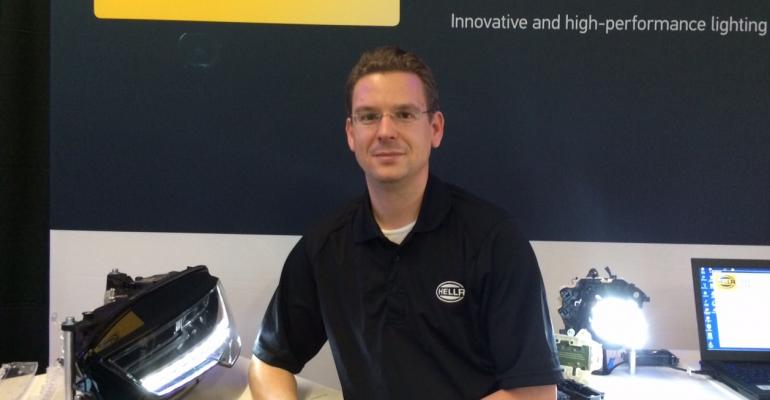DETROIT – A jarring alarm may successfully get people out of a burning building, but arguably that’s not the best way to signal drivers of a perilous traffic situation.
In fact, a bells-and-whistles-like automotive warning system can cause the opposite effect from the one intended: It can confuse and even panic a driver. Rattled motorists often react badly to road-related emergencies.
German auto supplier Hella has developed a warning system that uses strategically placed interior lights and light strips. The idea is to alert drivers without freaking them out. Moreover, the system is designed to visually tell a driver not only of a problem, but where it is.
Of course, automotive lighting depends on electricity. But Hella executives speak of modern electronics – in the form of sensors, radar and various detection systems – working together with interior and exterior lighting.
“The interplay between car lighting and electronics creates additional benefits,” says Kristian Doscher, the firm’s head of global marketing-original equipment. “In a dangerous situation, you use sensor technology to detect objects and use interior lighting to signal the driver and tell him where to look.”
Such objects would include pedestrians, bicyclists and other cars. If a vehicle sensor picks up, say, a bike rider on a collision course to the right of the auto, an A-pillar or door-panel light strip on that side of the car interior would illuminate.
“Seeing opposed to hearing is more intuitive, and a faster connection to the brain,” Doscher says of warning systems. “If a bell is ringing, what does it really tell you? It doesn’t tell you where to look. Our lighting system directs attention to exactly where the situation is.”
Many current safety systems use A-pillar lights to warn drivers of the presence of another car in a blind spot. The Hella system would take that up a notch.
Doscher also speaks of the need for agreeable human-machine interaction. “The demand more and more from our (OEM) customers is to make (systems) more intuitive.”
The interior-light warning system is expected to make its way into production vehicles soon. “We are in development talks with several OEMs,” Doscher tells WardsAuto. “There’s definitely an interest. We know it is coming.”
When? “Depending on the model, in 2017 or 2018.” Why isn’t it in vehicles today? “Honestly, I don’t know, because it is inexpensive technology.”
It is among various products Hella highlights in a display room on “suppliers day” at the North American International Auto Show.
Hella tries to make it a point of not just showing its latest offerings, but also demonstrating through use-case videos, animations and the like how they work in traffic situations, says Steffen Pietzonka, head of marketing-original equipment lighting.
Mere product displays fall short of conveying benefits and value to automaker customers, he says. “In the past, we’ve just shown components, from electronics to lighting. This year, we wanted to show how they work together.”
Among technology on display are systems that would:
- Sense and adjust to urban environmental circumstances such as smog. When high levels of pollutant particulates are detected in the air, the illumination of the car’s exterior lights increases to improve visibility. “It could help in places like Shanghai and Beijing,” Pietzonka says, referring to Chinese cities with major smog issues.
- Park a car autonomously in narrow spots. Smartphones activate the function. Obstacles such as shopping carts are detected, and the parking process is paused until they are removed.
Much of Hella’s current and impending technology centers on autonomous-car development. The company is eager to join that party.
Some people worry about what the future might hold in a world of self-driving vehicles. But more of a challenge is the impending transition period when autonomous and non-autonomous vehicles share the road, Doscher says.
“There will be a coexistence for at least 20 years before the complete public fleet goes autonomous,” he says. “We need to build a bridge from one to the other.”





